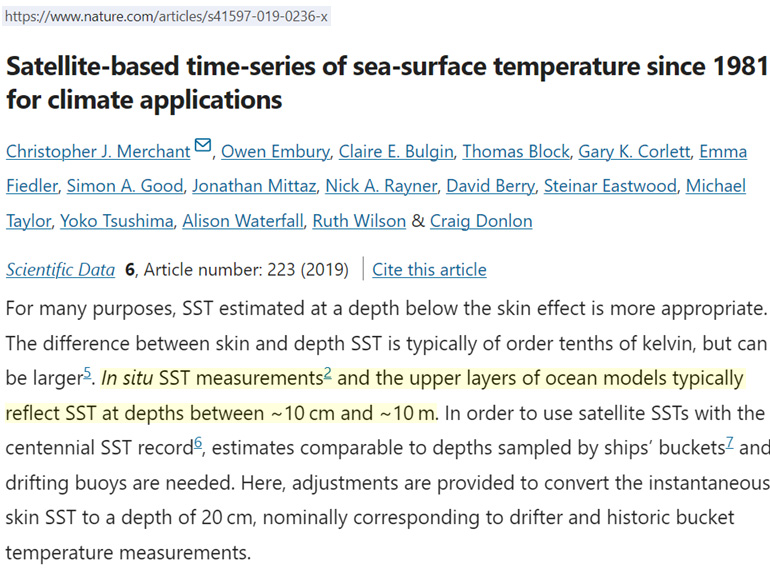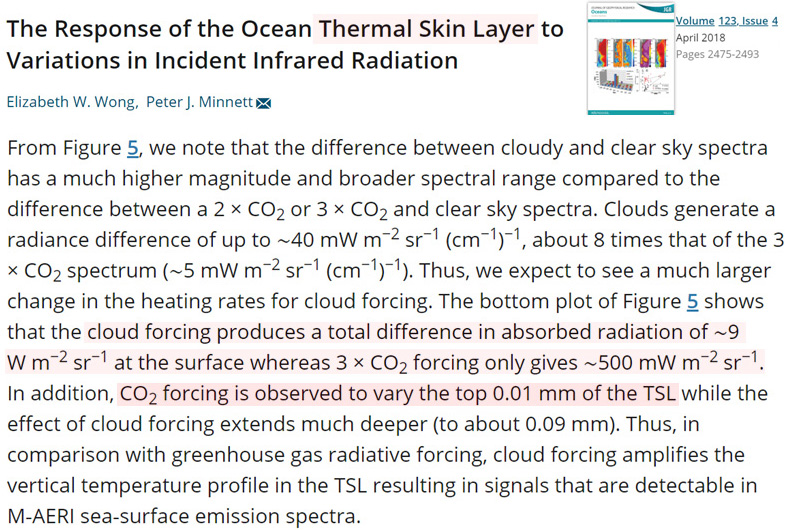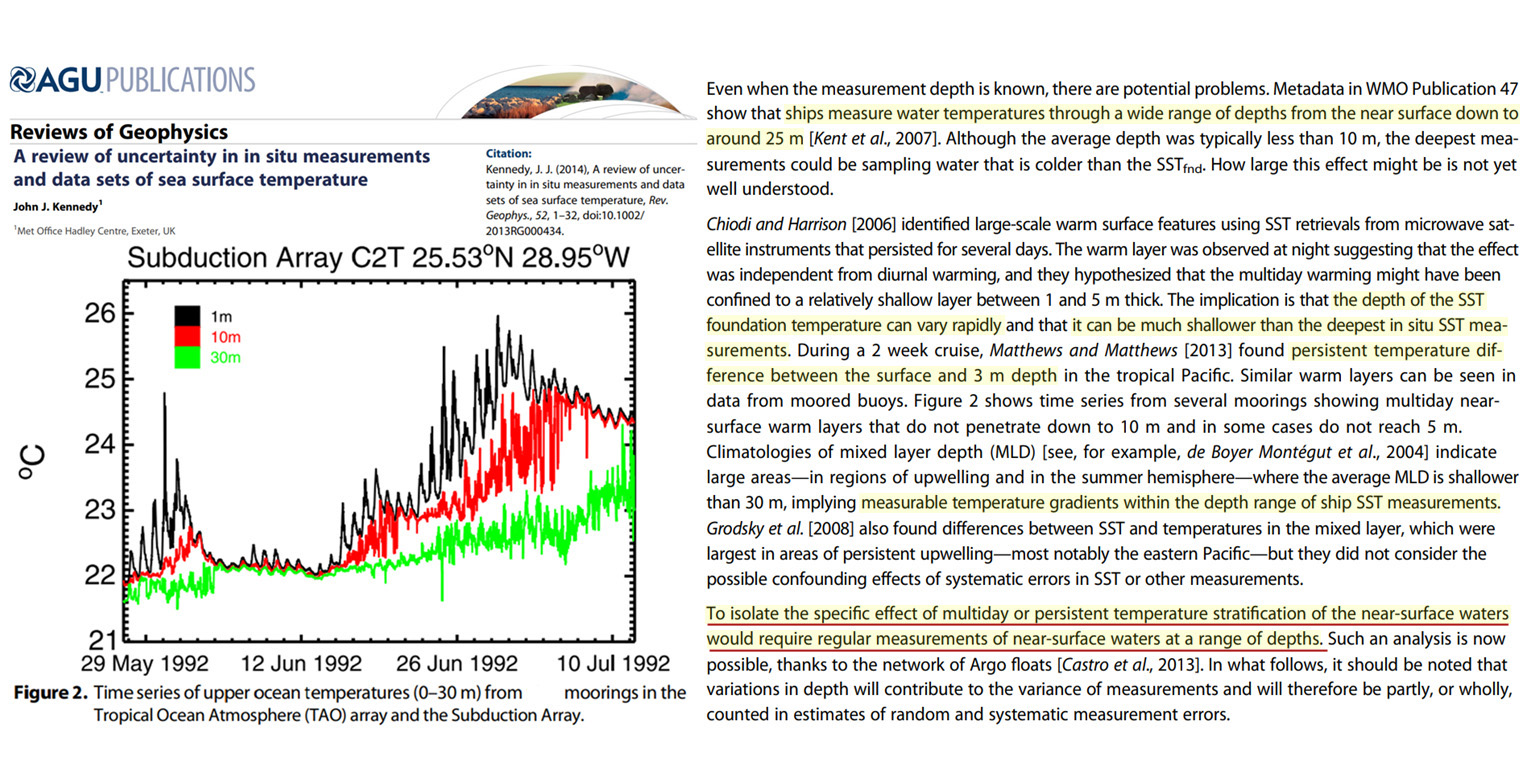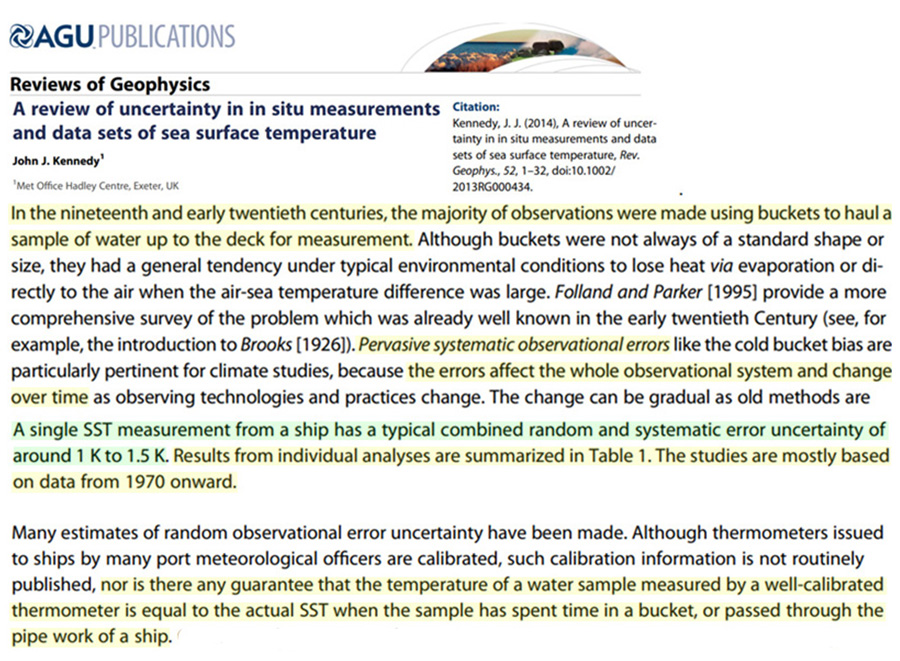The shallowest sea surface temperature measurement limit is 10,000 times deeper than the extent of CO2’s radiative influence.
When sea surface temperatures (SSTs) are measured, the depth range of the measurement typically extends from 10 cm to 10 m, or 100 mm to 10,000 mm (Merchant et al., 2019).

Image Source: Merchant et al., 2019
This measurement limitation is an insurmountable problem for those who wish to link increases in SSTs to increases in anthropogenic CO2 emissions.
Why? Because CO2’s radiative influence can only extend to ocean depths of 0.01 mm, or 1/100ths of a millimeter (Wong and Minnett, 2018).
CO2’s total impact on ocean temperatures cannot therefore be detected, as the shallowest SST measurements are 100 mm – 10,000 times deeper than the range limit for CO2’s radiative impact.

Image Source: Wong and Minnett, 2018
The physical impossibility of obtaining a detectable (and thus measurable) CO2 signal is not the only problem in attributing SST warming to anthropogenic CO2 emissions.
At a single site, SSTs can vary by as much as ±1-3°C, depending on depth. The water temperature at 1,000 mm (1 meter) may be 2°C warmer than at 10,000 mm (10 meters), depending on factors such as the time of day the measurement was taken, or if it was a cloudy versus sunny day (Kennedy, 2014). Pulling a wooden bucket out of the water from a ship deck – which is how SSTs were routinely measured until the late 20th century – can yield multiple degrees differences if the water in the bucket was hauled onto the ship at 7 a.m. rather than 3 p.m.

Image Source: Kennedy, 2014
To accurately assess the SST for the locations where sailors pulled buckets out of the water, then, would require “regular measurements of near-surface waters at a range of depths” (Kennedy, 2014). These data are surely not available in the historical SST records.
Consequently, the “random and systematic error uncertainty” in every single buckets-derived SST measurement is about 1 to 1.5°C. With water covering 71% of the Earth’s surface, this error and uncertainty magnitude fully disqualifies any claim that instrumental data accurately reflect the global average surface temperature.






If I understood correctly the conclusions of Wong and Minnett the IR radiation retards the heat loss from the mixed layer. Thus, it must cool the atmosphere above the Oceans.
As a simple empirical observation, I remember standing waist-deep in the Baltic at a beach in the summer, and the difference in water temperature between the surface and a depth of less than one metre was remarkable.
It is correct that radiation from the sun (or from the moon, any other planet or from anything in the atmosphere eg an aeroplane) can only heat a few 10s of mm of the surface. Anyone one with a thermometer can make measurements in their swimming pool. This can only happen during the day. At night the pool surface radiates to space. Light can penetrate still water to about 100m but the energy in the light at that depth is insignificant.
However, to make the assumption that CO2 in the atmosphere can heat even one mm of the surface is nonsense.
For a start CO2 in the atmosphere can only absorb radiation of a wavelength of 14.8 micron which by Wien’s Displacement law is about 200K temperature which is around the top of the troposphere some 12km up from the surface which has been measured and set out in the lapse rate (environmental lapse rate is about -6.5K/km and adiabatic -9.8K/km). So everywhere in the atmosphere it is a lower temperature than the surface. The 2nd law of thermodynamics basically states that heat only flows from hot to cold. CO2 can not heat the surface of Earth which by some calculation is claimed to average about 288K. CO2 radiates to only space and that is why it can be detected by satellites around the Earth or other planets such as Venus and Mars (or planets light years away)
The physics tells you that. Specific heat ratio water to air is approx
1000
[…] The Effect Of CO2 Increases On Ocean Temperatures Is Too Small To Measurably Detect […]
If you have never stood on the bridge wing of an observing ship, with bucket, thermometer and torch, at midnight, in a howling gale- then you ain’t never lived 😀
Readings were normally six hourly from 00:00 local.
The idea that the difference between those manual readings, in whole degrees fahrenheit, and the more modern readings in centigade to several decimal points shows “Global Warming” is pure political twaddle.